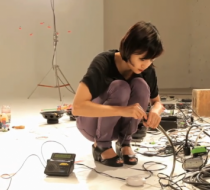Christine Sun Kim Favorite
For artist Christine Sun Kim, sound is a "ghost." The multiple-MFA-holding Senior TED Fellow who has had a Whitney Museum residency and exhibited at MoMA, has been profoundly deaf since birth. The sonic hush in which she lives has pushed her towards exploring sound through her work in a varied oeuvre of performance, installation, drawing, and video.
Initially, Kim strove to translate sound into direct visual terms. She experimented with vibrations, placing coated paintbrushes and inked quills on wooden boards atop subwoofers and speakers pulsing with ambient noise. Her process resulted in lovely minimalist paintings, audibles turned objets d'art. But the project felt like translating a text using only half the alphabet. "Low frequency sounds—vibrations—only make up a very small fraction of the sound world," she explains. When it came to capturing the rich tapestry of Kim's lived experience with sound, this approach fell short.
Recognizing that facilitating paint-stained traces of vibrations was only one component of making the sonic visible, Kim tried a different tack. The artist produced her own semiotics of sound by piecing together a tangle of overlapping languages and systems, including musical notation, body language, and American Sign Language (ASL), which she describes as similar to sound in its intrinsic spatiality.
Her information system make the rigid definition of sound as anesthetized vibrations meeting a hearing ear feel nothing short of antiquated. It does this by capturing life in a world where sound is funneled more through social interactions than through ears. Because of this, experiencing her work is similar to the moment when one realizes listening to the Kim spent much of her life mirroring others' relationships to sound in an effort to follow a culturally dominant "sound etiquette." Growing up animated in a less effusive Korean family (a facet, she points out, of both Korean and hearing cultures), Kim learned quietness—"to tone it down"—in response to eyes upon her. "At first I thought I experience sound mostly through vibrations, but I realized it's much more than that," she explains. "I'm mostly informed by the way people react and behave around it and then I in turn mirror them, sometimes out of good manners." In her artistic practice, Kim strives to reclaim sound, to carve out a space where sound doesn't revolve around some borrowed etiquette, but instead around her own distinct experience. song in the dark is different than hearing it in the light.
Kim's work is conceptually strong, but its real power comes from the way it honors and dignifies her own experience. In the perceptual regime that is hearing culture, Kim tells dominant sonic norms to go screw themselves. They represent a limiting etiquette, not her actual relationship with sound. As Kim pointed out in a past TED interview: "It was not like society gave me a clear, safe space to do whatever I wanted. I had to learn how to integrate their ways."
Kim's art doesn't acquiesce. It makes its own rules, taking sound on her own terms. And yet, even though she doesn't aim to be political and is more focused on expressing her personal trajectory, when reflecting on her art, one could point to that rallying cry of second-wave feminism: "The personal is political."







